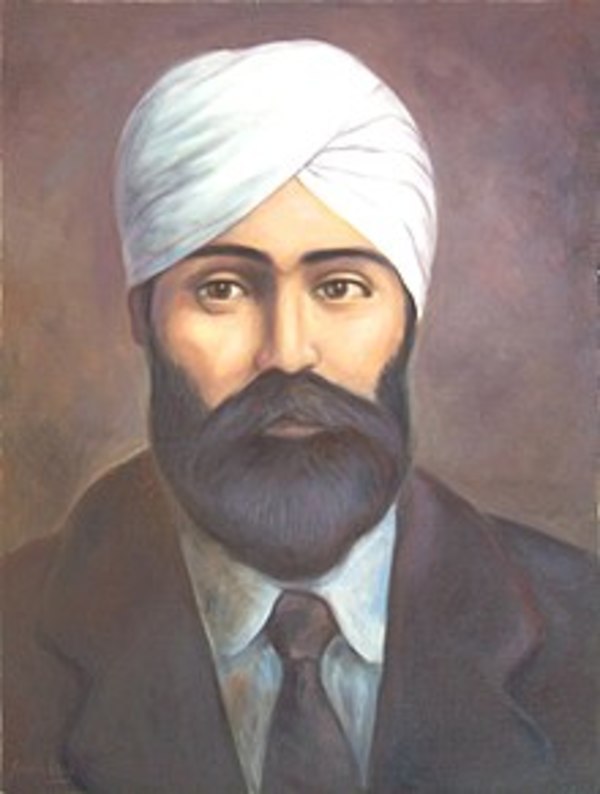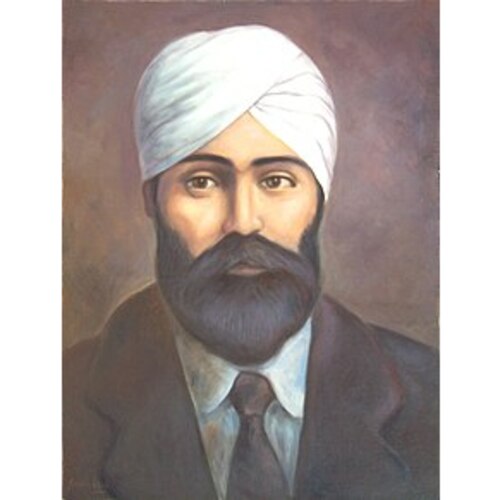
Source: Courtesy of Wikimedia Commons
SINGH, MEWA, labourer; b. c. 1881 in Lopoke, India, son of Nund Singh; never married; executed 11 Jan. 1915 in New Westminster, B.C.
Mewa Singh came to British Columbia in 1906. He was one of more than 5,000 Punjabi men who arrived in the three years before 1908, the date when the Canadian government stopped further immigration from India. Typical sojourning labourers attracted by relatively high wages, these men came without family and intended to return home once they had accumulated some capital. Like most of the Punjabis who stayed for several years instead of going to the United States or returning home, Mewa Singh found unskilled work in lumber mills.
In 1908 he was initiated as a Khalsa Sikh. Many nominal Sikhs of his era followed the teachings of the Sikh gurus without adopting the uncut hair and other emblems of the Khalsa Sikh discipline. Among Sikhs of his generation who immigrated to Canada, however, that discipline enjoyed a renaissance. As a Khalsa Sikh, Mewa Singh was active in the maintenance of the first Sikh temple in Vancouver and served as granthi, or scripture reader, during services, although he seems to have been a secondary figure in the temple leadership.
On 21 Oct. 1914 Mewa Singh shot and killed an immigration inspector, William Charles Hopkinson, who for him was the personal manifestation of British oppression. Hopkinson, born in India to an English father and Indian mother, had served in the Punjab and Calcutta police before coming to Canada. In 1909 he had entered the employ of the immigration branch, and he served as an intelligence agent responsible for the surveillance of Sikhs and other immigrants from India. His reports to the deputy minister of the interior were relayed to the Colonial Office, the India Office, and the viceroy of India, with copies reaching the director of criminal intelligence in Delhi. Every suggestion that Sikhs overseas advocated home rule for India or mutiny against the British was material for those reports. By 1913, with the formation of the San Francisco-based Gadar party, which promoted a revolutionary and anti-British message among Sikhs throughout the Pacific coast region, British and Indian officials were paying close attention to Hopkinson’s Work.
Mewa Singh came into contact with Hopkinson on 17 July 1914 when he was arrested on the Canadian side of the border with 500 rounds of ammunition and a revolver purchased in the United States. He had accompanied Bhag Singh, the president of the Vancouver temple society, and Balwant Singh, a scripture reader in the temple, on a trip to Sumas, Wash. There they had bought several revolvers and boxes of shells in a hardware store. Mewa Singh had come back first and was the only one arrested by the Canadian authorities. The Americans detained the other two but eventually released them. What Hopkinson and the immigration branch wanted from Mewa Singh was a statement that would implicate his companions in criminal or seditious activity. They warned him that he could receive ten years in prison if he did not cooperate, and after he gave a statement they let him off with a lesser charge. His story had not satisfied them, but Hopkinson evidently thought he could get more from him eventually. The incident left Mewa Singh in the potentially friendless ground between the immigration officials and the leaders of the temple.
Hopkinson’s presence in Vancouver had created two opposing factions among local Sikhs: his informants and their friends and relatives on the one hand, and the temple leaders and their allies on the other. Tensions were magnified by the prejudiced Canadian social and legal climate. During the summer of 1914 the unsuccessful efforts of the temple leadership to gain entry for 376 Punjabis stranded on the steamer Komagata Maru in the Vancouver harbour further aggravated the situation. But it became most explosive after war began in Europe. The Gadar party saw an opportunity to drive the British out of India and called on Sikhs to return home for the fight. In response, Hopkinson and his informants made lists of those who left by ship, identifying for police in India the ones considered most dangerous.
On 5 Sept. 1914 one of Hopkinson’s informants, Bela Singh, entered the Vancouver Sikh temple and discharged two revolvers into an assembly of thirty-five or forty men attending a funeral for a Sikh who had been shot two days before. Bela Singh wounded eight or nine, two of them fatally, Bhag Singh and another man. According to Mewa Singh, Bela Singh’s desecration of the temple decided him to kill Hopkinson. Perhaps he also viewed the occasion as a chance to rehabilitate his name.
Mewa Singh shot Hopkinson seven weeks later, in a corridor of the Vancouver court-house, prior to a grand jury hearing in Bela Singh’s case. He made no attempt to escape or resist arrest, seeking martyrdom. His trial took place the next week and lasted less than two hours. He offered no defence; his lawyer, Edward Montague Nelson Woods, did not cross-examine any of the crown witnesses and declined translation of their evidence, even though Mewa Singh’s comprehension of English was limited. Woods seems to have been following his client’s instructions. He did read to the court a lengthy statement by Mewa Singh, who said that he was giving his life to show that his people could not get justice in Canada.
Veneration of Mewa Singh began on the day of his execution, when a procession of 400 Sikhs carried his body four miles from the New Westminster jail to a funeral pyre at Fraser Mills, and it has continued with annual observances in Sikh temples to the present. If press commentary is an indication, however, the white majority in Vancouver saw his victim as the hero, and Mewa Singh’s act thus reinforced the isolation of the Sikh community.
Norman Buchignani et al., Continuous journey: a social history of South Asians in Canada ([Toronto], 1985). Hugh Johnston, “The surveillance of Indian nationalists in North America, 1908–1918,” BC Studies, no.78 (summer 1988): 3–27; The voyage of the “Komagata Maru”: the Sikh challenge to Canada’s colour bar (Delhi, India, 1979; 2nd ed., Vancouver, 1989). Richard Popplewell, “The surveillance of Indian ‘seditionists’ in North America, 1905–1915,” in Intelligence and international relations, 1900–1945, ed. Christopher Andrew and Jeremy Noakes (Exeter, Eng., 1987), 49–76. Kesar Singh, Canadian Sikhs and “Komagata Maru” massacre (1v. to date, Surrey, B.C., 1989– ). Teja Singh, Jiwan kath: Gurmukh piare Sant Atar Singh Ji Maharaj [The biography of a beloved follower of the guru, Saint Atar Singh Ji Maharaj] (Patiala, India, 1946; 4th ed., 1981). Mahinder Singh Dhillon, A history book of the Sikhs in Canada and California (Vancouver, 1981).
Cite This Article
Hugh J. M. Johnston, “SINGH, MEWA,” in Dictionary of Canadian Biography, vol. 14, University of Toronto/Université Laval, 2003–, accessed December 24, 2025, https://www.biographi.ca/en/bio/singh_mewa_14E.html.
The citation above shows the format for footnotes and endnotes according to the Chicago manual of style (16th edition). Information to be used in other citation formats:
| Permalink: | https://www.biographi.ca/en/bio/singh_mewa_14E.html |
| Author of Article: | Hugh J. M. Johnston |
| Title of Article: | SINGH, MEWA |
| Publication Name: | Dictionary of Canadian Biography, vol. 14 |
| Publisher: | University of Toronto/Université Laval |
| Year of publication: | 1998 |
| Year of revision: | 1998 |
| Access Date: | December 24, 2025 |



